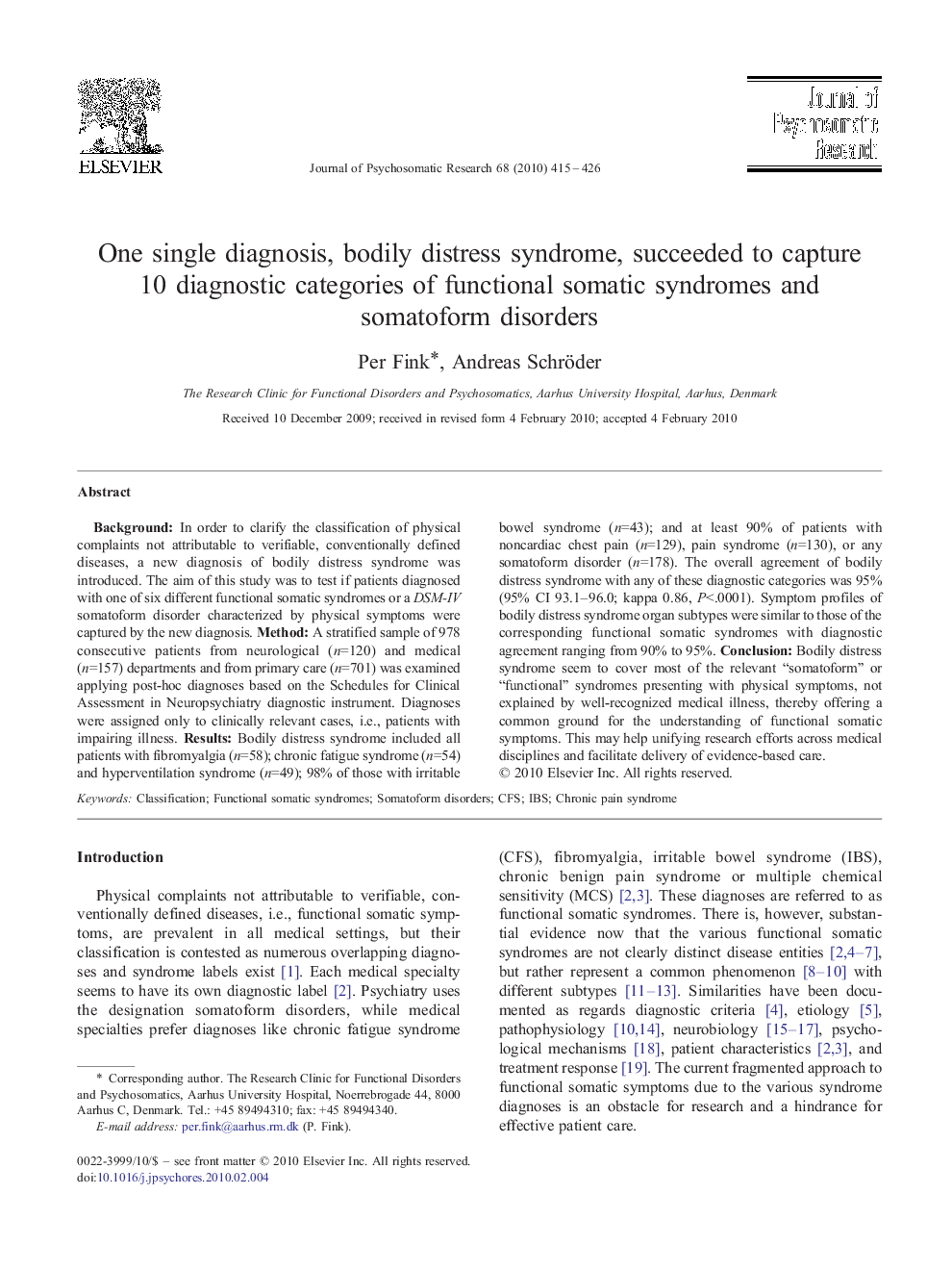انگیختگی ادراکی ایجاد حافظه های جدید اپیزودیک را بهبود می بخشد
| کد مقاله | سال انتشار | تعداد صفحات مقاله انگلیسی |
|---|---|---|
| 35787 | 2015 | 12 صفحه PDF |

Publisher : Elsevier - Science Direct (الزویر - ساینس دایرکت)
Journal : Journal of Psychosomatic Research, Volume 68, Issue 5, May 2010, Pages 415–426
چکیده انگلیسی
Background In order to clarify the classification of physical complaints not attributable to verifiable, conventionally defined diseases, a new diagnosis of bodily distress syndrome was introduced. The aim of this study was to test if patients diagnosed with one of six different functional somatic syndromes or a DSM-IV somatoform disorder characterized by physical symptoms were captured by the new diagnosis. Method A stratified sample of 978 consecutive patients from neurological (n=120) and medical (n=157) departments and from primary care (n=701) was examined applying post-hoc diagnoses based on the Schedules for Clinical Assessment in Neuropsychiatry diagnostic instrument. Diagnoses were assigned only to clinically relevant cases, i.e., patients with impairing illness. Results Bodily distress syndrome included all patients with fibromyalgia (n=58); chronic fatigue syndrome (n=54) and hyperventilation syndrome (n=49); 98% of those with irritable bowel syndrome (n=43); and at least 90% of patients with noncardiac chest pain (n=129), pain syndrome (n=130), or any somatoform disorder (n=178). The overall agreement of bodily distress syndrome with any of these diagnostic categories was 95% (95% CI 93.1–96.0; kappa 0.86, P<.0001). Symptom profiles of bodily distress syndrome organ subtypes were similar to those of the corresponding functional somatic syndromes with diagnostic agreement ranging from 90% to 95%.
مقدمه انگلیسی
Physical complaints not attributable to verifiable, conventionally defined diseases, i.e., functional somatic symptoms, are prevalent in all medical settings, but their classification is contested as numerous overlapping diagnoses and syndrome labels exist [1]. Each medical specialty seems to have its own diagnostic label [2]. Psychiatry uses the designation somatoform disorders, while medical specialties prefer diagnoses like chronic fatigue syndrome (CFS), fibromyalgia, irritable bowel syndrome (IBS), chronic benign pain syndrome or multiple chemical sensitivity (MCS) [2] and [3]. These diagnoses are referred to as functional somatic syndromes. There is, however, substantial evidence now that the various functional somatic syndromes are not clearly distinct disease entities [2], [4], [5], [6] and [7], but rather represent a common phenomenon [8], [9] and [10] with different subtypes [11], [12] and [13]. Similarities have been documented as regards diagnostic criteria [4], etiology [5], pathophysiology [10] and [14], neurobiology [15], [16] and [17], psychological mechanisms [18], patient characteristics [2] and [3], and treatment response [19]. The current fragmented approach to functional somatic symptoms due to the various syndrome diagnoses is an obstacle for research and a hindrance for effective patient care. Recently, bodily distress syndrome was introduced as an empirically based diagnosis that may help solve the problem of diagnostic confusion [12]. In contrast to the diagnoses of functional somatic syndromes and the somatoform disorders that have been developed on the basis of highly selected patient populations or just by consensus, the bodily distress syndrome diagnosis is based on a large representative sample of patients recruited from primary care, a neurological and an internal medical setting [12]. The patients were assessed by trained physicians for any physical symptoms and not only for symptoms belonging to a predefined (specialty-specific) symptom list. Furthermore, we applied an exploratory statistical approach that explores the relationship of the symptoms to each other without any presumption regarding symptom clusters. This is in contrast to the confirmatory approach that is very popular in classification research, but which can only confirm a predefined symptom structure. Although functional somatic symptoms form a continuum from few to many symptoms without clear “cut-off” to define the boundary of illness, one distinct bodily distress syndrome could be identified. Bodily distress syndrome could be divided into a severe, multiorgan type and a modest, single-organ type with symptoms primarily from one organ system. The single-organ type was further divided into four subtypes; a cardiopulmonary (CP), a gastrointestinal (GI), a musculoskeletal (MS) and a general symptoms (GS) type (Fig. 1). Since these symptom profiles are in line with various other studies [13] and [20], the finding of bodily distress syndrome subtypes seems to be quite robust. Full-size image (79 K) Fig. 1. Suggested new classification. Figure options We have previously hypothesized that bodily distress syndrome may replace most of the existing diagnostic categories of functional somatic syndromes and those of the somatoform disorders that are characterized by physical symptoms [21] (Fig. 1). This would be preferable to the approach proposed by the DSM-V workgroup on somatic symptom disorders which would entail two diagnoses: a “psychiatric” diagnosis on Axis I of “complex somatic symptom disorder” together with a “medical” diagnosis of a functional somatic syndrome on Axis III [22]. We believe that this proposed dual diagnosis solution would be a step backward in terms of attempting to unify the efforts of functional somatic syndrome research and to resolve the current dualistic diagnostic approach [23]. Very few previous studies have examined the overlap of the categories of the functional somatic syndromes and somatoform disorders, and no study to date has examined the unifying bodily distress syndrome approach against current diagnostic categories. In the current study, we aimed to test whether (1) patients fulfilling criteria for six different functional somatic syndromes and four different somatoform disorders were diagnosed by the new construct of bodily distress syndrome, (2) symptom profiles were comparable between specific functional somatic syndromes and their corresponding bodily distress syndrome subtypes, and (3) comorbidity rates with anxiety and depression differed between “medical” functional somatic syndromes, “psychiatric” somatoform disorders and the unifying bodily distress syndrome diagnosis.
نتیجه گیری انگلیسی
Bodily distress syndrome seem to cover most of the relevant “somatoform” or “functional” syndromes presenting with physical symptoms, not explained by well-recognized medical illness, thereby offering a common ground for the understanding of functional somatic symptoms. This may help unifying research efforts across medical disciplines and facilitate delivery of evidence-based care.

